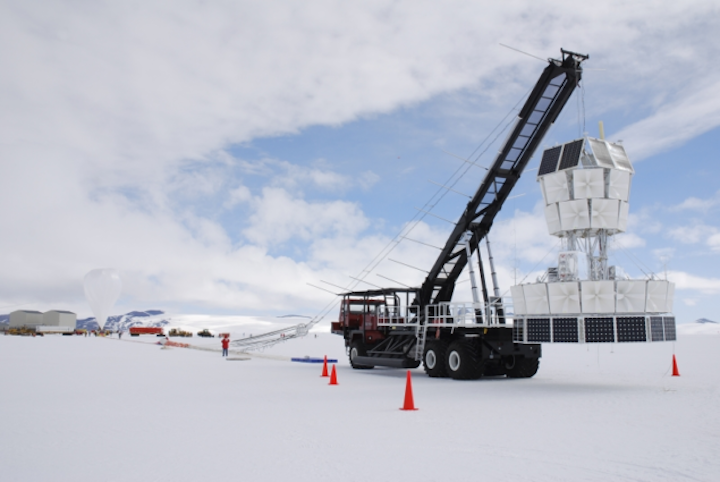19.07.2018

Physicists have been left scratching their heads following the observation of two unusual radio signals by the balloon-borne Antarctic Impulsive Transient Antenna (ANITA). While many other signals spotted by ANITA are produced by cosmic rays crashing down through the atmosphere, the two anomalous events seem to be caused by particles travelling up through the Earth’s crust. Those particles may be neutrinos but their properties seem at odds with the Standard Model of particle physics.
ANITA, developed by a US-led collaboration and funded by NASA, contains 96 radio antennas suspended from a helium balloon. Flying at an altitude of nearly 40 km for several weeks at a time, it detects radio waves emanating from a 1.3 million square kilometre swathe of Antarctica. Its primary purpose is to pick up the signals produced by cosmic neutrinos travelling from deep space to try and pinpoint the origin of ultra-high energy cosmic rays – which are believed to be produced in the same places as cosmic neutrinos.
The neutrinos of interest pass through the Earth and interact with atomic nuclei in the Antarctic ice sheets, producing a shower of charged particles that then emit radio waves. ANITA also picks up signals from cosmic rays as they travel downwards and collide with the atmosphere. This also generates radio waves, which bounce off the ice and into ANITA’s antennas.
Tell-tale polarizations
The two types of signal can be distinguished by measuring the radio waves’ polarization – signals from cosmic rays have horizontal polarization while neutrino signals have vertical polarization. In addition, the observatory separates out the small subset of air showers whose radio emissions do not bounce off the ice but instead travel straight towards it at a very shallow angle almost parallel to the ground. Since these waves are not reflected they don’t undergo a phase inversion, meaning they are 180˚ out of phase compared to the bouncing variety.
Data from ANITA’s first flight in 2006-7 contained one unusual-looking event. This was horizontally polarized and for all intents and purposes looked like a signal from a cosmic ray. It also underwent no phase inversion, suggesting that the originating particle would have travelled horizontally. However, the signal arrived at a much steeper angle – from well below the horizon.
Trying to explain what it had seen, Peter Gorham of the University of Hawaii and colleagues in the ANITA collaboration hypothesized that the signal was caused not by the air shower from a neutrino but by the air shower from a neutrino’s interaction product, probably a tau lepton. The idea is that a tau neutrino would interact either in or just below the ice, generating a tau lepton that would then continue along the neutrino’s trajectory but only decay once it had emerged from the ice. The resulting radio waves would therefore be horizontally polarized.
But this idea is problematic because, unlike neutrinos at lower energies, the kind of high-energy neutrino that would have been responsible for the signal should interact after travelling for just a few hundred kilometres through the Earth (a neutrino’s interaction cross section getting much bigger at higher energies). However, the researchers calculated, given the neutrino’s trajectory, that it must have passed through about 7000 km of solid matter – which they reckon it only had a one in 100,000 chance of doing so.
Human activities
Gorham says that the event may have been caused by human activities, but when he and his colleagues looked at data from ANITA’s third flight in 2014-15, they spotted a very similar looking signal. The researchers calculate that the two events constitute roughly 4σ evidence of an unexplainable anomaly. “It’s still possible that the events are due to two isolated people, each transmitting a single radio pulse very far from the nearest Antarctic base,” he says. “But that seems very unlikely at this stage.”
Alan Watson of the University of Leeds in the UK agrees that the signals are unlikely to be anthropogenic. A tau neutrino, on the other hand, he says, “seems reasonable”, but adds he is surprised that similar events have not been see by either the IceCube detector at the South Pole or the Pierre Auger Observatory in Argentina.
Alexander Kusenko of the University of California Los Angeles argues it is possible that the signals did in fact bounce off the ice but didn’t undergo a phase inversion, perhaps because they reflected off a lower density layer beneath the surface. Pavel Motloch of the University of Chicago, meanwhile, suggests that the neutrinos’ interaction cross-section may have been miscalculated. “The calculations are experimentally verified at much smaller energies than ANITA probes and extrapolation is always dangerous,” he says.
Cosmic switch-on
Another possibility explored by Gorham’s group is the switching on of a very powerful source of cosmic neutrinos at just the right point in space and time to provide the flux needed to overcome Earth’s stopping power. Scouring astrophysical catalogues, he and his colleagues found a possible source for the second event – a supernova observed in 2014 – but no obvious candidates for the first.
That leaves the door open to more exotic possibilities. Indeed, says Gorham, several theorists are now assessing whether the unusual events could be related to sterile neutrinos – exceptionally inert cousins of normal neutrinos predicted by some extensions of the Standard Model that a few groups claim to have evidence for. The idea is that sterile neutrinos would traverse most of the Earth before transforming into tau neutrinos just below the surface.
However, Gorham acknowledges that solving the mystery will not be easy. “Such limited statistics make it hard to really pin down the cause of the anomalous events,” he says. “But we will keep trying.”
The research is reported in a paper on arXiv that has been accepted for publication in Physical Review Letters.
Quelle: physicsworld
